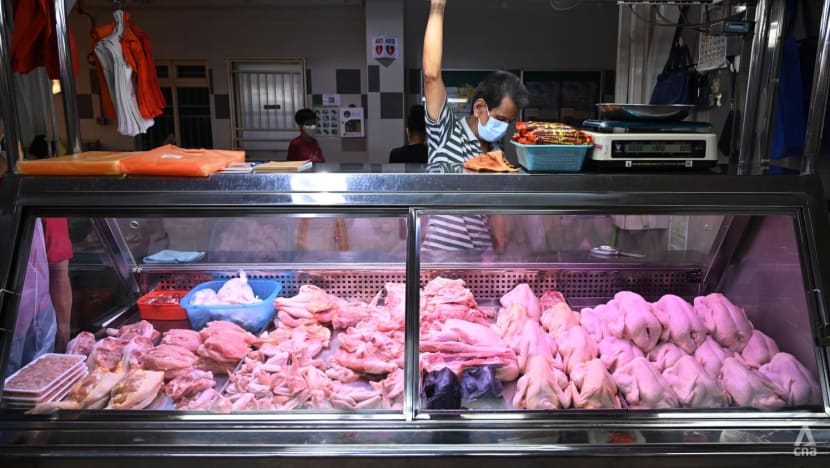Singapore importers bring in kampung and black chickens from Malaysia after export ban is partially lifted
www.channelnewsasia.com

SINGAPORE: Malaysia has partially lifted a chicken export ban, allowing poultry importers in Singapore to resume bringing in live kampung and black chickens from Tuesday (Jun 14).
In a letter from the Department of Veterinary Services of Malaysia seen by CNA, the authorities said that exports of live kampung and black chicken will be allowed again, following a Cabinet decision on Jun 8.
The letter also said that exports of poultry products such as nuggets or hotdogs will be allowed to resume. However, the ban on commercial broiler chicken - the larger birds that make up the bulk of the chickens Singapore usually imports from Malaysia - remains.
The letter did not specify the quantity of live kampung and black chickens that will be available for export.
Malaysia imposed a ban on chicken exports on Jun 1 to ensure sufficient supply in the domestic market.
Singapore imports about 34 per cent of its chicken supply from Malaysia, almost all of which is brought in as live chickens that are then slaughtered and chilled locally.
In the days leading up to the ban and after, chickens were in high demand in Singapore, with prices rising. Some chicken rice stalls also shut down temporarily.
Mr Ma Chin Chew, secretary of Singapore’s Poultry Merchants’ Association and CEO of Hup Heng Poultry Industries, confirmed that his company resumed importing live kampung and black chickens on Tuesday.
The poultry will be sold to wet market sellers, hawkers and restaurants from Wednesday.
Chicken importer Kee Song Food also announced on its TikTok page that it would be selling live chicken from Jun 15.
Mr Ma expressed relief at the partial lifting of the export ban, but also expressed concern about the quantity available.
Broiler chicken is the main source of income for Hup Heng Poultry Industries, which used to import about 100,000 to 120,000 broiler chickens a day. This compares with imports of about 5,000 to 10,000 black chickens and 30,000 to 40,000 kampung chickens per day.
“It’s neither here nor there because the cost of the kampung chicken is much higher than the normal broiler chicken, so I don’t think customers will want to fully switch to selling kampung chicken for the time being,” Mr Ma told CNA.
The volume and availability of kampung and black chickens are also limited, he said.
“(If a) Customer only orders 20 chickens and then I deliver to the stalls, instead of 100 or 200 birds, it actually costs me more.”
www.channelnewsasia.com

SINGAPORE: Malaysia has partially lifted a chicken export ban, allowing poultry importers in Singapore to resume bringing in live kampung and black chickens from Tuesday (Jun 14).
In a letter from the Department of Veterinary Services of Malaysia seen by CNA, the authorities said that exports of live kampung and black chicken will be allowed again, following a Cabinet decision on Jun 8.
The letter also said that exports of poultry products such as nuggets or hotdogs will be allowed to resume. However, the ban on commercial broiler chicken - the larger birds that make up the bulk of the chickens Singapore usually imports from Malaysia - remains.
The letter did not specify the quantity of live kampung and black chickens that will be available for export.
Malaysia imposed a ban on chicken exports on Jun 1 to ensure sufficient supply in the domestic market.
Singapore imports about 34 per cent of its chicken supply from Malaysia, almost all of which is brought in as live chickens that are then slaughtered and chilled locally.
In the days leading up to the ban and after, chickens were in high demand in Singapore, with prices rising. Some chicken rice stalls also shut down temporarily.
Mr Ma Chin Chew, secretary of Singapore’s Poultry Merchants’ Association and CEO of Hup Heng Poultry Industries, confirmed that his company resumed importing live kampung and black chickens on Tuesday.
The poultry will be sold to wet market sellers, hawkers and restaurants from Wednesday.
Chicken importer Kee Song Food also announced on its TikTok page that it would be selling live chicken from Jun 15.
Mr Ma expressed relief at the partial lifting of the export ban, but also expressed concern about the quantity available.
Broiler chicken is the main source of income for Hup Heng Poultry Industries, which used to import about 100,000 to 120,000 broiler chickens a day. This compares with imports of about 5,000 to 10,000 black chickens and 30,000 to 40,000 kampung chickens per day.
“It’s neither here nor there because the cost of the kampung chicken is much higher than the normal broiler chicken, so I don’t think customers will want to fully switch to selling kampung chicken for the time being,” Mr Ma told CNA.
The volume and availability of kampung and black chickens are also limited, he said.
“(If a) Customer only orders 20 chickens and then I deliver to the stalls, instead of 100 or 200 birds, it actually costs me more.”

